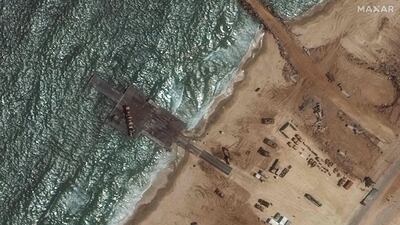Almost two weeks since becoming operational off the coast of Gaza, much of a vast pier built by the US military to help increase the flow of aid into the enclave is nowhere to be seen.
It has been taken up the coast to the Israeli city of Ashdod for critical repairs after large sections broke off in stormy seas.
Since US President Joe Biden announced the scheme in March, his administration has offered the pier as proof of how seriously it is taking the mission to ease Gaza’s humanitarian crisis, while remaining firm backers of Israel’s war there.
The pier is a major undertaking. It has cost $320 million and three US troops have so far been injured in the mission.
But critics of the project – there are many, including key US partners in the humanitarian sector – say it is symbolic of a contradiction at the heart of American policy towards the Gaza war.
They say Mr Biden could instead use his vast influence over Israel to get it to speed up aid deliveries, by far the most efficient way of rushing in supplies.
Now, battered by the Mediterranean, the pier is also quickly becoming a symbol of US chaos.
It lasted only 11 days before bad weather left it inoperable. Despite taking months to build, it will still only ever be a limited means of supply, even if it reaches the initial daily delivery target of 150 lorries.
Before the war, Gaza received a daily average of about 500 lorries of aid. Daily need is now even higher because of the humanitarian crisis.
According to Israel’s Co-ordination of Government Activities in the Territories, 105 lorries entered the enclave using the pier over the 11-day period it was operational, giving it an average daily rate of fewer than 10 lorries. That is a tiny, expensive drop in the ocean in terms of what is needed.
This chaos comes as agencies and the UN warn of renewed critical humanitarian pressure as Israeli forces continue operations in the southern city of Rafah, which have already led to a large civilian death toll.

Since the pier broke down, the US has been keen to highlight the inevitable complexity of such operations.
US National Security Adviser John Kirby said on Wednesday that the pier was never expected to be a “panacea for all the humanitarian assistance problems that still exist in Gaza”.
“We knew going in that this was going to be tough stuff and it has proven to be tough stuff," he added.
But humanitarian agencies and NGOs say that even if a sustainable, full-capacity operation gets up and running, big obstacles remain.
Many of these groups are particularly concerned about a lack of engagement from US government organisations behind the project, especially the Department of Defence and USAid.
They report still being left with little understanding about how the US views their role in the operation, in terms of how aid supplied by the organisations can be shipped to the pier and how they then distribute it within Gaza.
The World Food Programme, the UN agency that is in part responsible for the project, is also said to be providing little guidance. But the extent to which the US is engaging the WFP, which declined to comment on its role in the project, is unclear.
The US promises the pier will be up and running again in about a week. Even then, it is uncertain how long it will operate until the next breakdown and, even with perfect summer weather, whether the pier will ever deliver its target amount of aid.


